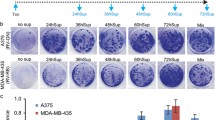Abstract
To identify the importance of IRAK2 kinase activity in TLR-mediated signaling pathways, we constructed a retroviral vector harboring either a mouse IRAK2 gene (IRAK2-WT) or with its mutant with loss of function of its ATP-binding site (IRAK2-KD). Further, we comparatively analyzed for the gain of function and modulations in TLR-mediated signaling pathways in IRAK2 knockout (IRAK2-KO) macrophages upon introduction of the IRAK2-WT retroviral constructs. The pBS/IRAK2-KD with the ATP-binding site mutation in IRAK2 was obtained by using site-specific mutagenesis. The recombinants were identified with appropriate double digestion and sequence analysis. The recombinant vector constructs were transfected by lipofection into phoenix packaging cells. The viral vectors (107 cfu/mL) with the construct were allowed to infect IRAK2-KO macrophages. The results showed that IRAK2-WT gene overexpressed in the IRAK2-KO macrophages exhibited a modified IRAK2 expression upon LPS induction. However, the modification was absent with IRAK2-KD construct on LPS stimulation; instead, the IRAK2 protein stability was reduced considerably. The results further show that the LPS-induced effect on the stability of IRAK2 is dependent of IRAK4 stimulation.




Similar content being viewed by others
References
Akira, S. (2006). TLR signaling. Current Topics in Microbiology and Immunology, 311, 1–16.
Keating, S. E., Maloney, G. M., Moran, E. M., & Bowie, A. G. (2007). IRAK-2 participates in multiple toll-like receptor signaling pathways to NFkappaB via activation of TRAF6 ubiquitination. The Journal of Biological Chemistry, 282, 33435–33443.
Kawagoe, T., Sato, S., Matsushita, K., Kato, H., Matsui, K., Kumagai, Y., et al. (2008). Sequential control of Toll-like receptor-dependent responses by IRAK1 and IRAK2. Nature Immunology, 9, 684–691.
Anderson, P. (2008). Post-transcriptional control of cytokine production. Nature Immunology, 9, 353–359.
Hitti, E., Iakovleva, T., Brook, M., Deppenmeier, S., Gruber, A. D., Radzioch, D., et al. (2006). Mitogen-activated protein kinase-activated protein kinase 2 regulates tumor necrosis factor mRNA stability and translation mainly by altering tristetraprolin expression, stability, and binding to adenine/uridine-rich element. Molecular and Cellular Biology, 26, 2399–2407.
Ronkina, N., Kotlyarov, A., Dittrich-Breiholz, O., Kracht, M., Hitti, E., Milarski, K., et al. (2007). The mitogen-activated protein kinase (MAPK)-activated protein kinases MK2 and MK3 cooperate in stimulation of tumor necrosis factor biosynthesis and stabilization of p38 MAPK. Molecular and Cellular Biology, 27, 170–181.
Wan, Y. Z., Xiao, H., Affolter, J., Kim, T. W., Bulek, K., Chaudhuri, S., et al. (2009). Interleukin-1 receptor-associated kinase 2 is critical for lipopolysaccharide-mediated post-transcriptional control. Journal of Biological Chemistry, 284, 10367–10375.
Aruffo, A., & Seed, B. (1987). Molecular cloning of two CD7 (T-cell leukemia antigen) cDNAs by a COS cell expression system. The EMBO Journal, 6, 3313–3316.
Aruffo, A., & Seed, B. (1987). Molecular cloning of a CD28 cDNA by a high-efficiency COS cell expression system. Proceedings of the National Academy of Sciences of the United States of America, 84, 8573–8577.
Seed, B., & Aruffo, A. (1987). Molecular cloning of the CD2 antigen, the T-cell erythrocyte receptor, by a rapid immunoselection procedure. Proceedings of the National Academy of Sciences of the United States of America, 84, 3365–3369.
Muzio, M., Ni, J., Feng, P., & Dixit, V. M. (1997). IRAK (Pelle) family member IRAK-2 and MyD88 as proximal mediators of IL-1 signaling. Science, 278, 1612–1615.
Cao, Z., Henzel, W. J., & Gao, X. (1996). IRAK: A kinase associated with the interleukin-1 receptor. Science, 271, 1128–1131.
Onishi, M., Kinoshita, S., Morikawa, Y., Shibuya, A., Phillips, J., Lanier, L. L., et al. (1996). Applications of retrovirus-mediated expression cloning. Experimental Hematology, 24, 324–329.
Iida, A., Chen, S. T., Friedmann, T., & Yee, J. K. (1996). Inducible gene expression by retro-virus mediated transfer of a modified tetracycline-regulated system. Journal of Virology, 70, 6054–6059.
Akira, S., Takeda, K., & Kaisho, T. (2001). Toll-like receptors: Critical proteins linking innate and acquired immunity. Nature Immunology, 2, 675–680.
Cao, Z., Xiong, J., Takeuchi, M., Kurama, T., & Goeddel, D. V. (1996). TRAF6 is a signal transducer for interleukin-1. Nature, 383, 443–446.
Deng, L., Wang, C., Spencer, E., Yang, L., Braun, A., You, J., et al. (2000). Activation of the IkappaB kinase complex by TRAF6 requires a dimeric ubiquitin-conjugating enzyme complex and a unique polyubiquitin chain. Cell, 103, 351–361.
Ninomiya-Tsuji, J., Kishimoto, K., Hiyama, A., Inoue, J., Cao, Z., & Matsumoto, K. (1999). The kinase TAK1 can activate the NIK-IκB as well as the MAP kinase cascade in the IL-1 signalling pathway. Nature, 398, 252–256.
Funding
This work was supported by Natural Science Foundation of Guangdong Province (No. 2015A030313691), Public interest and ability construction funds in Guangdong Province (No. 2014A020212036).
Author information
Authors and Affiliations
Corresponding author
Rights and permissions
About this article
Cite this article
Liu, Y., Yin, W., Xu, L. et al. Identification of a Constitutively Active Mutant Mouse IRAK2 by Retroviral Expression Screening. Mol Biotechnol 60, 245–250 (2018). https://doi.org/10.1007/s12033-018-0064-9
Published:
Issue Date:
DOI: https://doi.org/10.1007/s12033-018-0064-9




